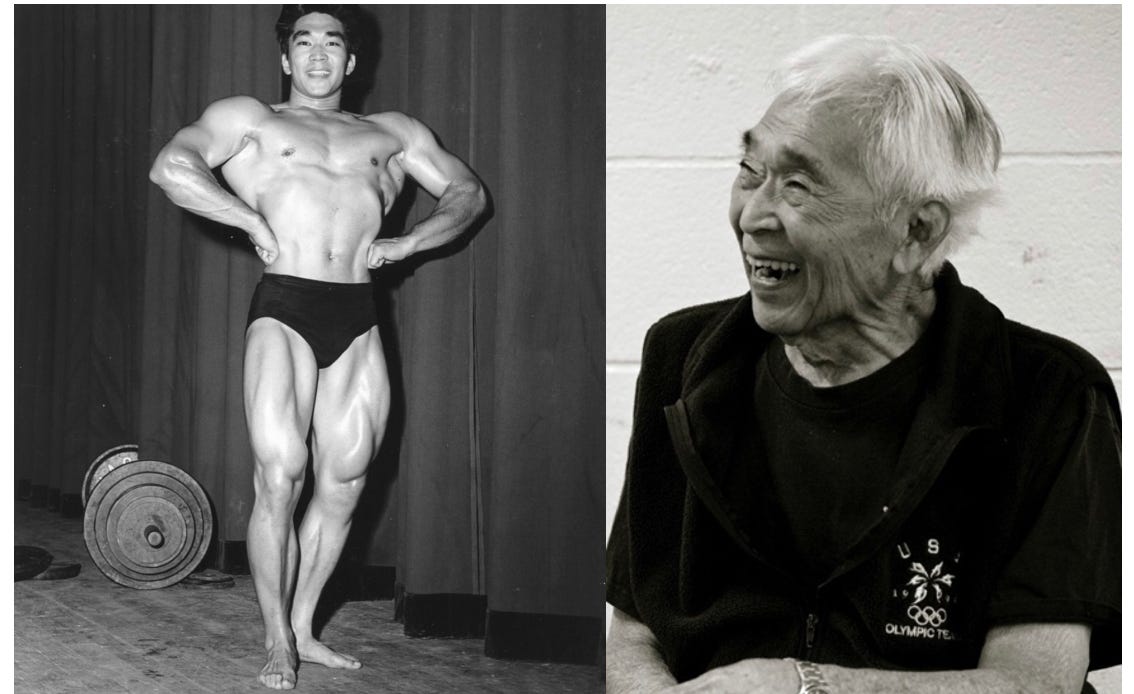AS GOOGLE HONORS TOMMY KONO – WE EMPHASIZE STAYING PHYSICALLY FIT AS YOU AGE
Michelle MishaFit Nguyen, MSHA, CPT, SFS and Stephen Z. Fadem, MD, FASN
Tamia “Tommy” Kono was honored by Google as one of the greatest weightlifters of all time. He would have been 91 years old on June 27 but died April 24, 2016. His past history was characterized by captivity in a Japanese internment camp during World War 2. As a child, he was weak and frail. Ironically, the desert air at the camp’s location near the California-Oregon border proved beneficial in combating his severe asthma. He ultimately set 26 world records and is the only weightlifter in history to hold world records in four different weight divisions. He was also inducted into the US Olympic Hall of Fame and the International Weightlifting Hall of Fame.
The first photograph above on the left was taken in the 1950s; the second was taken the year prior to his death in 2015. Sarcopenia, or age-related muscle loss, is a natural part of aging. Unfortunately, muscles deteriorate as we age. Without regular exercise, people over the age of 50 are prone to health problems, including decreased muscle mass, strength, and physical endurance, as well as decreased mobility, flexibility, and balance. The earlier one begins exercising, the easier it is to detect any health problems. It is also advised to not stop exercising because you could gain weight, become depressed, lose control over blood sugar, have decreased muscle mass, lose strength and endurance, as well as sleep.
As our muscles weaken, we are at greater risk for falling and for sustaining a fracture. The question becomes how can we prevent muscle loss and how can we build muscles back. The science behind muscle loss is complex but seems to rest on several premises.
1. Inflammation is associated with muscle loss. Some diets and some diseases are associated with inflammation, and patients should bring up muscle preservation with their physicians.
2. Kidney disease, which is associated with metabolic acidosis, is associated with sarcopenia. Bicarbonate tablets and dietary changes to a plant-based diet may preserve kidney function, although it is not clear whether they will preserve muscle function.
3. Even though testosterone levels decline with age, there are adverse effects associated with using testosterone supplements, which have not been approved by the FDA.
4. Protein supplements and increasing dietary protein intake may help in patients who have normal kidney function. For kidney patients who should restrict their dietary protein consumption, ketoanalogs are a suitable substitute.
5. An exercise training program may help preserve muscle function. Exercising without proper training could lead to injuries such as ligament sprains and strained muscle tendons. It is advised to seek the services of a Senior Fitness Specialist, a certified personal trainer who is able to assist in the development of a healthier lifestyle for older adults, as well as help prevent injury and allow one to maximize the workout experience.
Exercising is the most effective way to prevent and reverse sarcopenia. For older adults, exercising is one of the most important benefits you can do for your health. It is never too late to start exercising. Even people who begin an exercise regimen later in life are surprised at how much better they feel and how much more energy they have. For adults, the goal should be to gradually increase your physical activity to the recommended 150 minutes of moderate intensity a week. However, for older adults who are unable to reach the recommended goal, they should keep in mind that some physical activity is better than none at all; hence, they should only be as physically active as their abilities and health conditions allow.
Types of exercises include resistance or strength training, which increases muscle strength and endurance using resistance bands or weights. Exercises include:
a.) Wall push-ups or modified push-ups (with knees on the ground)
b.) Step-ups
c.) Sit-to-stand
d.) Seated curls
e.) Tricep kickbacks
f.) Lateral raises
g.) Hammer or preacher curl
h.) Standing band shoulder row

